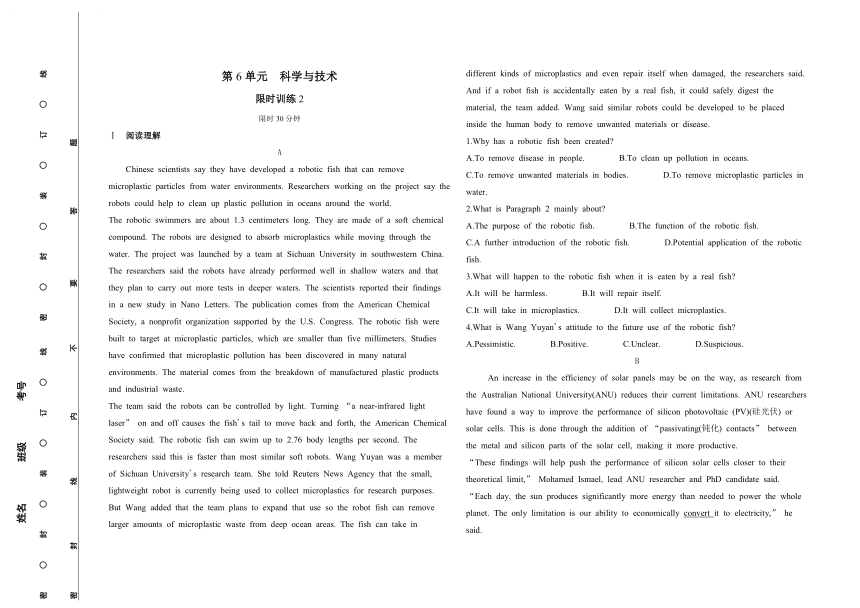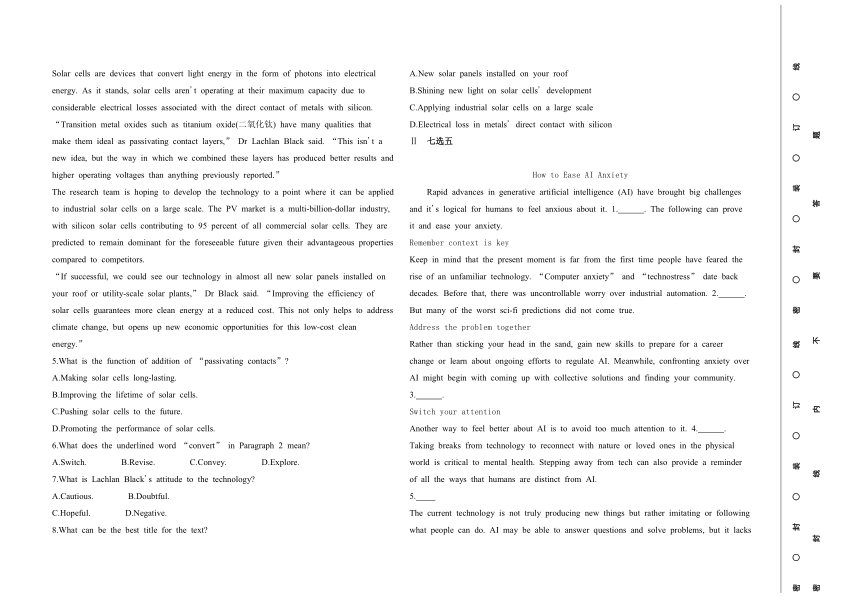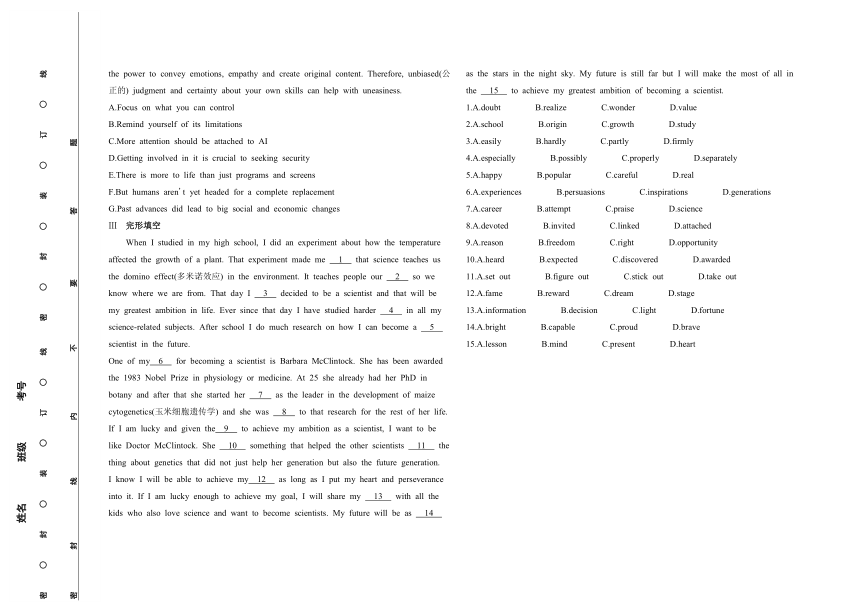 資源簡介
資源簡介
第6單元 科學與技術
限時訓練2
限時30分鐘
Ⅰ 閱讀理解
A
Chinese scientists say they have developed a robotic fish that can remove microplastic particles from water environments. Researchers working on the project say the robots could help to clean up plastic pollution in oceans around the world.
The robotic swimmers are about 1.3 centimeters long. They are made of a soft chemical compound. The robots are designed to absorb microplastics while moving through the water. The project was launched by a team at Sichuan University in southwestern China. The researchers said the robots have already performed well in shallow waters and that they plan to carry out more tests in deeper waters. The scientists reported their findings in a new study in Nano Letters. The publication comes from the American Chemical Society, a nonprofit organization supported by the U.S. Congress. The robotic fish were built to target at microplastic particles, which are smaller than five millimeters. Studies have confirmed that microplastic pollution has been discovered in many natural environments. The material comes from the breakdown of manufactured plastic products and industrial waste.
The team said the robots can be controlled by light. Turning “a near-infrared light laser” on and off causes the fish's tail to move back and forth, the American Chemical Society said. The robotic fish can swim up to 2.76 body lengths per second. The researchers said this is faster than most similar soft robots. Wang Yuyan was a member of Sichuan University's research team. She told Reuters News Agency that the small, lightweight robot is currently being used to collect microplastics for research purposes. But Wang added that the team plans to expand that use so the robot fish can remove larger amounts of microplastic waste from deep ocean areas. The fish can take in different kinds of microplastics and even repair itself when damaged, the researchers said. And if a robot fish is accidentally eaten by a real fish, it could safely digest the material, the team added. Wang said similar robots could be developed to be placed inside the human body to remove unwanted materials or disease.
1.Why has a robotic fish been created
A.To remove disease in people. B.To clean up pollution in oceans.
C.To remove unwanted materials in bodies. D.To remove microplastic particles in water.
2.What is Paragraph 2 mainly about
A.The purpose of the robotic fish. B.The function of the robotic fish.
C.A further introduction of the robotic fish. D.Potential application of the robotic fish.
3.What will happen to the robotic fish when it is eaten by a real fish
A.It will be harmless. B.It will repair itself.
C.It will take in microplastics. D.It will collect microplastics.
4.What is Wang Yuyan's attitude to the future use of the robotic fish
A.Pessimistic. B.Positive. C.Unclear. D.Suspicious.
B
An increase in the efficiency of solar panels may be on the way, as research from the Australian National University(ANU) reduces their current limitations. ANU researchers have found a way to improve the performance of silicon photovoltaic (PV)(硅光伏) or solar cells. This is done through the addition of “passivating(鈍化) contacts” between the metal and silicon parts of the solar cell, making it more productive.
“These findings will help push the performance of silicon solar cells closer to their theoretical limit,” Mohamed Ismael, lead ANU researcher and PhD candidate said. “Each day, the sun produces significantly more energy than needed to power the whole planet. The only limitation is our ability to economically convert it to electricity,” he said.
Solar cells are devices that convert light energy in the form of photons into electrical energy. As it stands, solar cells aren't operating at their maximum capacity due to considerable electrical losses associated with the direct contact of metals with silicon.
“Transition metal oxides such as titanium oxide(二氧化鈦) have many qualities that make them ideal as passivating contact layers,” Dr Lachlan Black said. “This isn't a new idea, but the way in which we combined these layers has produced better results and higher operating voltages than anything previously reported.”
The research team is hoping to develop the technology to a point where it can be applied to industrial solar cells on a large scale. The PV market is a multi-billion-dollar industry, with silicon solar cells contributing to 95 percent of all commercial solar cells. They are predicted to remain dominant for the foreseeable future given their advantageous properties compared to competitors.
“If successful, we could see our technology in almost all new solar panels installed on your roof or utility-scale solar plants,” Dr Black said. “Improving the efficiency of solar cells guarantees more clean energy at a reduced cost. This not only helps to address climate change, but opens up new economic opportunities for this low-cost clean energy.”
5.What is the function of addition of “passivating contacts”
A.Making solar cells long-lasting.
B.Improving the lifetime of solar cells.
C.Pushing solar cells to the future.
D.Promoting the performance of solar cells.
6.What does the underlined word “convert” in Paragraph 2 mean
A.Switch. B.Revise. C.Convey. D.Explore.
7.What is Lachlan Black's attitude to the technology
A.Cautious. B.Doubtful.
C.Hopeful. D.Negative.
8.What can be the best title for the text
A.New solar panels installed on your roof
B.Shining new light on solar cells' development
C.Applying industrial solar cells on a large scale
D.Electrical loss in metals' direct contact with silicon
Ⅱ 七選五
How to Ease AI Anxiety
Rapid advances in generative artificial intelligence (AI) have brought big challenges and it's logical for humans to feel anxious about it. 1. . The following can prove it and ease your anxiety.
Remember context is key
Keep in mind that the present moment is far from the first time people have feared the rise of an unfamiliar technology. “Computer anxiety” and “technostress” date back decades. Before that, there was uncontrollable worry over industrial automation. 2. . But many of the worst sci-fi predictions did not come true.
Address the problem together
Rather than sticking your head in the sand, gain new skills to prepare for a career change or learn about ongoing efforts to regulate AI. Meanwhile, confronting anxiety over AI might begin with coming up with collective solutions and finding your community. 3. .
Switch your attention
Another way to feel better about AI is to avoid too much attention to it. 4. . Taking breaks from technology to reconnect with nature or loved ones in the physical world is critical to mental health. Stepping away from tech can also provide a reminder of all the ways that humans are distinct from AI.
5.
The current technology is not truly producing new things but rather imitating or following what people can do. AI may be able to answer questions and solve problems, but it lacks the power to convey emotions, empathy and create original content. Therefore, unbiased(公正的) judgment and certainty about your own skills can help with uneasiness.
A.Focus on what you can control
B.Remind yourself of its limitations
C.More attention should be attached to AI
D.Getting involved in it is crucial to seeking security
E.There is more to life than just programs and screens
F.But humans aren't yet headed for a complete replacement
G.Past advances did lead to big social and economic changes
Ⅲ 完形填空
When I studied in my high school, I did an experiment about how the temperature affected the growth of a plant. That experiment made me 1 that science teaches us the domino effect(多米諾效應) in the environment. It teaches people our 2 so we know where we are from. That day I 3 decided to be a scientist and that will be my greatest ambition in life. Ever since that day I have studied harder 4 in all my science-related subjects. After school I do much research on how I can become a 5 scientist in the future.
One of my 6 for becoming a scientist is Barbara McClintock. She has been awarded the 1983 Nobel Prize in physiology or medicine. At 25 she already had her PhD in botany and after that she started her 7 as the leader in the development of maize cytogenetics(玉米細胞遺傳學) and she was 8 to that research for the rest of her life.
If I am lucky and given the 9 to achieve my ambition as a scientist, I want to be like Doctor McClintock. She 10 something that helped the other scientists 11 the thing about genetics that did not just help her generation but also the future generation.
I know I will be able to achieve my 12 as long as I put my heart and perseverance into it. If I am lucky enough to achieve my goal, I will share my 13 with all the kids who also love science and want to become scientists. My future will be as 14 as the stars in the night sky. My future is still far but I will make the most of all in the 15 to achieve my greatest ambition of becoming a scientist.
1.A.doubt B.realize C.wonder D.value
2.A.school B.origin C.growth D.study
3.A.easily B.hardly C.partly D.firmly
4.A.especially B.possibly C.properly D.separately
5.A.happy B.popular C.careful D.real
6.A.experiences B.persuasions C.inspirations D.generations
7.A.career B.attempt C.praise D.science
8.A.devoted B.invited C.linked D.attached
9.A.reason B.freedom C.right D.opportunity
10.A.heard B.expected C.discovered D.awarded
11.A.set out B.figure out C.stick out D.take out
12.A.fame B.reward C.dream D.stage
13.A.information B.decision C.light D.fortune
14.A.bright B.capable C.proud D.brave
15.A.lesson B.mind C.present D.heart
答案全解全析
限時訓練2
Ⅰ.閱讀理解
A
語篇解讀 本文是一篇說明文。文章對科學家們新開發(fā)出的一種可以清除水中微塑料顆粒的機器魚進行了相關介紹。
1.D 細節(jié)理解題。根據(jù)第一段“Chinese scientists say they have developed a robotic fish that can remove microplastic particles from water environments. Researchers working on the project say the robots could help to clean up plastic pollution in oceans around the world.”可知,發(fā)明機器魚是為了清除水中的微塑料顆粒。故選D。
2.C 主旨大意題。根據(jù)第二段內(nèi)容可知,本段介紹了這種機器魚的長度、材料、用途、目標以及在水下的工作表現(xiàn),所以本段主要是對這種機器魚進行進一步的介紹。故選C。
3.A 細節(jié)理解題。根據(jù)最后一段中的“And if a robot fish is accidentally eaten by a real fish, it could safely digest the material, the team added.”可知,如果機器魚不小心被真魚吃下去了,也能安全地被真魚消化,不會產(chǎn)出有害的物質(zhì),即它是無害的。故選A。
4.B 推理判斷題。根據(jù)最后一段中的“the small, lightweight robot is currently being used to...added that the team plans to expand that use so the robot fish can remove larger amounts of microplastic waste from deep ocean areas...Wang said similar robots could be developed to be placed inside the human body to remove unwanted materials or disease.”可知,她所在的團隊將擴大機器魚的應用,下一步可以開發(fā)類似的機器人。因此,王宇嫣對于這種機器魚是持有積極、肯定態(tài)度的。故選B。A.悲觀的;C.不清楚的;D.懷疑的。
B
語篇解讀 本文是一篇說明文。澳大利亞國立大學(ANU)的研究人員發(fā)現(xiàn)了一種提高硅光伏或太陽能電池性能的方法,這將有助于提高太陽能電池的效率。
5.D 細節(jié)理解題。根據(jù)第一段中的“ANU researchers have found a way to improve the performance of silicon photovoltaic (PV) or solar cells. This is done through the addition of ‘passivating contacts’...”可知,澳大利亞國立大學的研究人員發(fā)現(xiàn)了一種提高硅光伏或太陽能電池性能的方法,這是通過在太陽能電池的金屬和硅部件之間增加“鈍化接觸”來實現(xiàn)的,使其更有效。故選D。
6.A 詞義猜測題。根據(jù)畫線詞上句“Each day, the sun produces significantly more energy than needed to power the whole planet.(太陽每天產(chǎn)生的能量遠遠超過了整個地球所需的能量。)”并結合畫線詞所在句“The only limitation is our ability to economically convert it to electricity(唯一的限制是我們把太陽能高效地 為電能的能力)”可推測,convert意為“轉換”,與 switch同義。故選A。
7.C 推理判斷題。根據(jù)最后一段中Lachlan Black說的話“This not only helps to address climate change, but opens up new economic opportunities for this low-cost clean energy.(這不僅有助于應對氣候變化,而且為這種低成本的清潔能源開辟了新的經(jīng)濟機會。)”可知,他對該技術抱有希望。故選C。
8.B 主旨大意題。根據(jù)第一段并結合其他內(nèi)容可知,文章主要介紹了澳大利亞國立大學的研究人員發(fā)現(xiàn)了一種提高硅光伏或太陽能電池性能的方法,這將有助于提高太陽能電池的效率,所以B項“太陽能電池發(fā)展的新亮點”符合文章主旨,關鍵詞是“solar cells”。故選B。
熟詞生義
address 熟義:n.地址 v.寫上姓名和地址 生義:v.設法解決
難句分析
原句 As it stands, solar cells aren't operating at their maximum capacity due to considerable electrical losses associated with the direct contact of metals with silicon.
分析 本句為主從復合句。As引導非限制性定語從句;在主句中,due to...作原因狀語,associated with...作定語修飾electrical losses。
譯文 就目前的情況看,由于金屬與硅的直接接觸造成了相當大的電損耗,太陽能電池無法以最大容量運行。
Ⅱ.七選五
語篇解讀 本文是一篇說明文。文章講述了生成式人工智能(AI)的快速發(fā)展帶來了巨大的挑戰(zhàn),并介紹了緩解人工智能帶來的焦慮的方法。
1.F 過渡句。根據(jù)空前“生成式人工智能(AI)的快速發(fā)展帶來了巨大的挑戰(zhàn),人類對此感到焦慮是合乎邏輯的”和空后“下面(的方法)可以證明這一點,并緩解你的焦慮”可知,F項“But humans aren't yet headed for a complete replacement(但人類還沒有找到完全的替代品)”承上啟下,符合語境。故選F。
2.G 過渡句。根據(jù)空前“‘電腦焦慮’和‘技術壓力’可以追溯到幾十年前。在此之前,人們對工業(yè)自動化有著無法控制的擔憂”和空后“但許多最糟糕的科幻預言并沒有成為現(xiàn)實”可知,G項“Past advances did lead to big social and economic changes(過去的進步確實帶來了巨大的社會和經(jīng)濟變革)”承上啟下,符合語境。故選G。
3.D 細節(jié)句。根據(jù)本段的小標題“一起解決問題”和空前“與此同時,解決人工智能帶來的焦慮可以從提出集體解決方案和找到你的團體開始”可知,D項“Getting involved in it is crucial to seeking security(參與其中對尋求安全至關重要)”承接上文,符合語境,其中的it指的是“提出集體解決方案和找到你的團體”。故選D。
4.E 細節(jié)句。根據(jù)本段的小標題“轉移你的注意力”和空前“另一種對人工智能感覺更好的方法是避免過多關注它”可知,E項“There is more to life than just programs and screens(生活不僅僅是程序和屏幕)”承接上文,符合語境。故選E。
5.B 主旨句。設空處是本段的小標題。下文說的是人工智能的局限性,所以B項“Remind yourself of its limitations(提醒自己它的局限性)”符合本段的主題。故選B。
技巧點撥
解答這類題目時通常采用瀏覽的方式,即重點搜索本段的主題線索詞并快速理清主旨大意,然后瀏覽選項,準確判定與主旨大意匹配的選項。
Ⅲ.完形填空
語篇解讀 本文是一篇記敘文。作者決定成為科學家,她的榜樣是1983年獲得諾貝爾生理學或醫(yī)學獎的芭芭拉·麥克林托克,希望自己能和她一樣做出有益的發(fā)現(xiàn)。
1.B 根據(jù)前文“That experiment”、后文“science teaches us the domino effect in the environment”并結合選項可知,“那個實驗讓我意識到科學教會了我們環(huán)境中的多米諾效應”符合語境,這讓作者決定成為科學家。doubt懷疑;realize意識到;wonder想知道;value重視。故選B。
2.B 根據(jù)后文“we know where we are from”可知,它讓我們知道我們來自哪里,所以是告訴我們起源。school學校;origin起源;growth增長;study學習。故選B。
3.D 根據(jù)后文“Ever since that day I have studied harder 4 in all my science-related subjects.”可知,作者更加努力地學習, 在所有與科學相關的科目上,所以作者堅定地想成為一名科學家。easily容易地;hardly幾乎不;partly部分地;firmly堅定地。故選D。
4.A 根據(jù)前文“That day I 3 decided to be a scientist and that will be my greatest ambition in life.”可知,作者堅定地想成為一名科學家,所以他特別是在所有與科學相關的科目上會更努力地學習。especially特別;possibly可能;properly適當?shù)?separately分別地。故選A。
5.D 作者堅定地決定成為一名科學家,所以是做了很多關于如何在未來成為一名真正的科學家的研究。happy高興的;popular流行的;careful仔細的;real真正的。故選D。
6.C 根據(jù)后文“achieve my ambition as a scientist, I want to be like Doctor McClintock”可知,作者想成為像芭芭拉·麥克林托克博士那樣的人,所以她是激勵作者成為科學家的人之一。experience經(jīng)歷;persuasion信仰;inspiration鼓舞人心的人;generation一代人。故選C。
7.A 根據(jù)后文“as the leader in the development of maize cytogenetics”可知,成為玉米細胞遺傳學發(fā)展的領導者應是她的事業(yè)。career事業(yè);attempt企圖;praise贊揚;science科學。故選A。
8.A 25歲時,她已經(jīng)獲得了植物學博士學位,之后,她成為玉米細胞遺傳學發(fā)展的領導者,并將她的余生獻給了這項研究。 be devoted to為固定搭配,意為“獻身于”。devote奉獻;invite邀請;link聯(lián)系;attach附,貼。故選A。
9.D 根據(jù)前文“If I am lucky and given”以及后文“to achieve my ambition as a scientist”可知,此處是作者在做假設,結合選項可知,應是“有機會實現(xiàn)我作為一名科學家的抱負”。reason原因;freedom自由;right權利;opportunity機會。故選D。
10.C 根據(jù)前文“She has been awarded the 1983 Nobel Prize in physiology or medicine.”可知,麥克林托克獲得諾貝爾獎,而根據(jù)常識,獲獎是因為發(fā)現(xiàn)了一些東西。hear聽到;expect預期;discover發(fā)現(xiàn);award獎勵。故選C。
11.B 麥克林托克獲得諾貝爾獎,所以她發(fā)現(xiàn)的東西應是幫助其他科學家弄清楚了遺傳學的事情,才能獲獎。set out出發(fā);figure out理解,弄清楚;stick out伸出;take out除掉。故選B。
12.C 根據(jù)后文“I put my heart and perseverance into it”可知,作者把心和毅力投入其中,是為了實現(xiàn)成為科學家的夢想。 fame名聲;reward獎勵;dream夢想;stage階段。故選C。
13.D 根據(jù)前文“If I am lucky enough to achieve my goal”可知,此處是說如果作者幸運地成為科學家,他會把自己的好運分享給所有同樣熱愛科學并想成為科學家的孩子們。information信息;decision決定;light光線;fortune好運。故選D。
14.A 根據(jù)后文“the stars in the night sky”可知,作者的未來將會像星星一樣,應該是明亮的。bright明亮的;capable有能力的;proud自豪的;brave勇敢的。故選A。
15.C 根據(jù)前文“My future is still far”可知,作者的未來還很遙遠,所以作者應是利用現(xiàn)在的一切來實現(xiàn)他的夢想。lesson教訓;mind頭腦;present目前;heart內(nèi)心。故選C。
展開更多......
收起↑
 資源預覽
資源預覽


